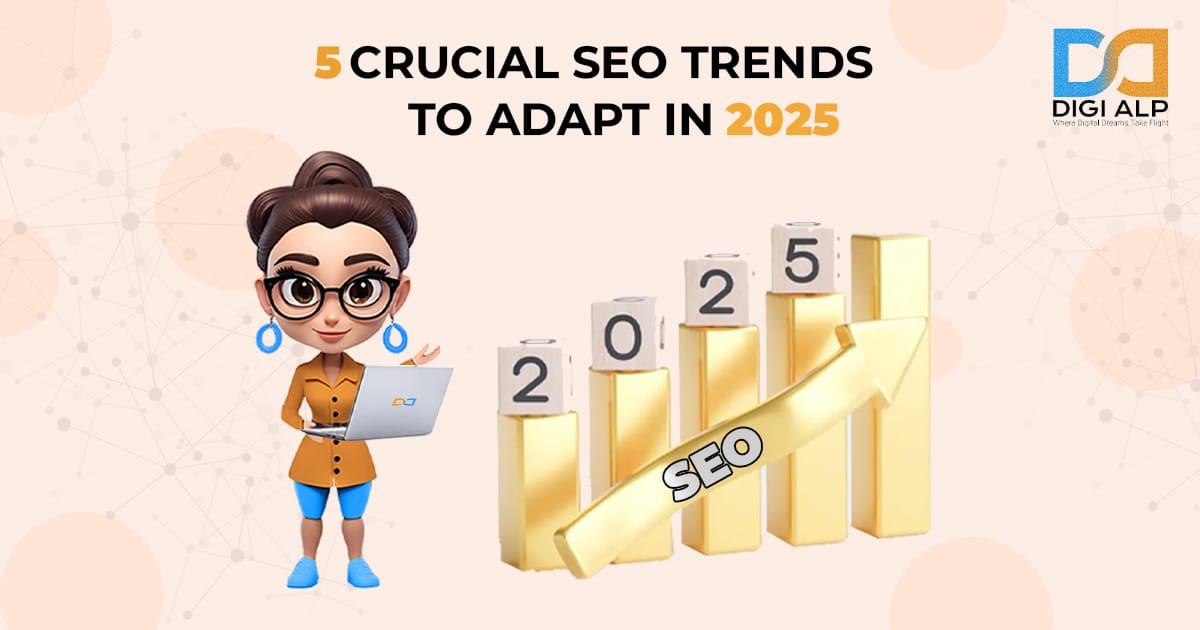he SEO landscape in 2025 is evolving faster than ever, driven by AI integration, search intent shifts, and enhanced user expectations. To stay competitive, businesses must look beyond traditional tactics and adapt to these five crucial SEO trends shaping the future.
1. AI-Powered Search Experience Optimization
Google’s AI Mode and Search Generative Experience (SGE) are fundamentally changing how users interact with search results. Instead of relying solely on keyword-based listings, Google now uses AI to summarize content and answer queries directly within the search interface.
What This Means for SEO:
- Less visibility for organic links unless your content is cited by AI.
- Increased competition for AI citations, not just rankings.
- Shift from keyword-matching to context-based answers.
How to Adapt:
- Write clear, structured, and authoritative content.
- Implement schema markup for FAQs, reviews, products, and articles.
- Prioritize E-E-A-T (Experience, Expertise, Authoritativeness, Trustworthiness).
2. Voice & Conversational Search Optimization
With the rise of smart assistants (Siri, Google Assistant, Alexa), voice search is more popular than ever. And in 2025, conversational queries dominate mobile and smart device usage.
Why This Matters:
- Voice search uses natural language and question-based phrasing.
- Users expect direct and concise answers.
- Local and mobile SEO becomes more important with voice queries.
How to Adapt:
- Optimize content for long-tail and question-based keywords (e.g., “How can I increase website traffic?”).
- Use structured data to enhance voice-read snippets.
- Focus on featured snippets and concise answers at the top of your content.
3. User Experience (UX) as a Ranking Signal
Google continues to prioritize Core Web Vitals, page usability, and overall user satisfaction. In 2025, UX is not just about loading speed—it’s about how users feel when navigating your site.
Core UX Metrics to Watch:
- Page Load Time
- Interactivity (First Input Delay)
- Visual Stability (Cumulative Layout Shift)
- Mobile responsiveness
- Accessibility and navigation clarity
How to Adapt:
- Optimize page speed using tools like Google PageSpeed Insights or Lighthouse.
- Use responsive design and test on real devices.
- Simplify navigation and ensure logical content structure.
- Focus on clean UI and reduce clutter.
4. Content Depth, Relevance & Freshness
Gone are the days when 500-word articles stuffed with keywords ranked well. In 2025, SEO demands in-depth, original, and regularly updated content that satisfies real search intent.
What Search Engines Want:
- Topical authority: Are you covering your niche comprehensively?
- Content freshness: Is your information up to date?
- User intent match: Does your content answer the specific question?
How to Adapt:
- Create pillar content and topic clusters for your niche.
- Update old content with new stats, trends, or insights.
- Use tools like SurferSEO, Clearscope, or MarketMuse to analyze depth.
5. Visual and Video SEO
Google has significantly improved how it indexes and surfaces visual content, especially video snippets, image results, and short-form content like YouTube Shorts or TikTok clips.
Why It Matters:
- Video often ranks above text results.
- Google indexes visual metadata and transcribes video content.
- Visual search is becoming mainstream (e.g., Google Lens).
How to Adapt:
- Add SEO-optimized alt text to every image.
- Use video schema markup to boost discoverability.
- Create short, engaging videos with clear titles, transcripts, and closed captions.
- Host videos on platforms like YouTube and embed them into your pages.





